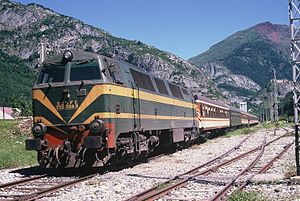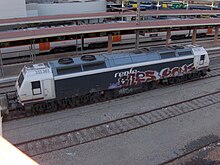| Renfe Class 333 | |||||||||||||||||||||||||||||||||||||||
|---|---|---|---|---|---|---|---|---|---|---|---|---|---|---|---|---|---|---|---|---|---|---|---|---|---|---|---|---|---|---|---|---|---|---|---|---|---|---|---|
 Renfe Class 333 Renfe Class 333 | |||||||||||||||||||||||||||||||||||||||
| |||||||||||||||||||||||||||||||||||||||
| |||||||||||||||||||||||||||||||||||||||
| |||||||||||||||||||||||||||||||||||||||
| |||||||||||||||||||||||||||||||||||||||
The Renfe Series 333 are high power six-axle diesel-electric locomotives built in the 1970s; at the time of their introduction they were the most powerful non-electric locomotives in Spain.
After three decades of service the class were rebuilt incorporating Alstom's newer technology, and thus extending their life - these rebuilt machines were given the sub-class names 333.3 and 333.4
Background
In the early 1970s, Renfe's dieselization program, with classes 316 (former 1600) and 318 (former 1800) CC locomotives, later followed by the more numerous classes 319 (former 1900) and 321 (former 2100), had displaced steam-powered traction and were responsible for much of the work requiring medium-powered locomotives. On the other hand, diesel-hydraulic class 340 (former 4000), based on the German V 200, initially intended for hauling express trains at the Madrid-Barcelona railway and other non-electrified lines, were suffering many failures from poor maintenance and being assigned to slow cargo trains. This is why Renfe was looking for a new diesel engined locomotive capable of both hauling express trains and high-tonnage heavy freight trains nationwide at a maximum speed of 62 mph.
The Class 319, produced in collaboration between Macosa and General Motors, had shown good performance, which influenced the decision to choose a locomotive of the General Motors type GT 26, (3,300 hp (2,500 kW)). In this series of locomotives, instead of taking the typical single cabin General Motors design it was decided to use a two cabined design; the Scandinavian manufacturer NOHAB had also been producing GM engined locomotives (having acquired a license to produce GM engined locomotives of its own designs), and a model was chosen based on the JT-26 with the Nohab bi-cabin box (See DSB class MZ) which was used by the Danske Statsbaner (DSB).
Renfe chose the variant model MZ1 which had a power output of almost 4,000 hp (3,000 kW), they were also able to supply electrical train heating - a first in Spain.
Technical

The locomotives were equipped with General Motors engines, generators, traction motors and electrical equipment. The diesel engines are 45-degree offset 16 cylinder V engined, two-stroke designs (EMD 645), with a compression ratio of 14.5:1, and a displacement of 645 cubic inches (10.57 litres) per cylinder, giving a total engine displacement of 10,320 cu.in (169.12 l).
The available power for traction is 2,514 hp - produced at 600 V AC, and is rectified to DC through two groups of 30 silicon diodes, and eventually supplies six nose suspended traction motors which drive the wheels via a pinion gear at a ratio of 59:18.
The maximum speed was rated at 146 km/h (91 mph), though some of the class can travel at 160 km/h (99 mph) with appropriate modifications. The bogies are of the 'flexicoil' type.
ASFA, a Spanish train safety system was also fitted (See Train protection system)
Service history and operators
The 93 units of the original series were ordered from Macosa for Renfe and delivered in several batches between 1974 and 1976. The first units were assigned to Madrid Atocha depot, where they progressively replaced class 340 on the Madrid-Burgos railway and later in other lines. Despite so, they were outran in 13 minutes by well-maintained class 340 on the 329 mile stretch between Madrid and Móra la Nova.
Other class 333 hauled services was the legendary express train from Barcelona to A Coruña/Vigo via Roda de Barà, la Plana-Picamoixons and Miranda de Ebro. Other notable services were the fast Madrid to Canfranc, and the locomotives use in dragging the Madrid to Vigo Pendular service until the line was electrified.
Ourense-junction to Medina del Campo route was served by the class 333s, which also were found in applications such as transporting coal from Samper de Calanda to thermal power stations in Andorra, and working in pairs to bring ore from Ojos Negros to the steel works at Sagunto.
On 1 January 2005 a law came into effect that began the de-monopolisation of the Spanish railway system - one effect of this new law was that private rail companies could now operate services in Spain alongside existing Renfe services. Two companies "Continental Rail" (part of ACS) and "Acciona Rail" bought Class 333.3 locomotives to operate freight services.
Variants and rebuilds
Part of this class were destined to have a second life, some were upgraded in the 1990s, and yet more were totally rebuilt in the early part of the 2000s to meet new demands and at the same some losing the locomotive's distinctly 'Viking' appearance. With the rebuilding complete none of the original type remain in service.
Subclass 333.0
These are the remainder of the original 93 locomotives, consisting of the locomotives that have remained unrebuilt, and un-upgraded. They are (or were) numbered 333.001 to 333.093
Subclass 333.1
Eight locomotives had new bogies fitted suitable for 160 km/h operation in the early 1990s forming the subclass 333.1 They are numbered 333.101 to 333.108 and are intended for passenger operation.
Subclass 333.2
In the 1990s four locomotives intended for mixed operation had new bogies fitted including gearing suitable for 140 km/h operation forming the subset 333.2 They are numbered 333.201 to 333.204
Subclass 333.3
From 2000 to 2005, a total of 92 locomotives were produced from new using some components from the original series; only the engine (or prime mover) and generators as well as the ASFA train protection system were reused - the rest of the locomotive being completely new type with input from Alstom. The control electronics have been upgraded from the system of relays and contactors with a block rectifier with power electronics which are electronically controlled by microprocessors and software. The traction motors have been updated from the D-77 to D-78 type, and the fuel capacity was increased from 4,500 to 7,200 litres.
The new designs have a top speed of 120 km/h, and are intended for freight traffic. The rebuild gives improvement of 8–10% in tractive effort over the original machines, which is explained by the use of the power electronics system.
No. 333.304 (previously 333.050) was destroyed in an accident at Chinchilla de Montearagón in 2003.
Subclass 333.4
Between 2003 and 2004 eight of the converted 333.3 machines were converted to 140 km/h running for passenger services and given the classification "333.4"
Subclasses-
333.031 with freight at Teruel (2005)
-
Class 333.101 pulling talgo cars (c.2006)
-
 333.203 at with talgo cars (2010)
333.203 at with talgo cars (2010)
-
333.328 showing the new design of bodyshell (2005)
-
 333.407 with talgo cars (2010)
333.407 with talgo cars (2010)
See also
- Renfe Class 334, a similar model to the rebuilt 333.3 and 333.4 sub types, except in that it uses a different GM-EMD engine.
- Stadler Euro, locomotives that may technically include the Class 334, and were built at the same plant in Valencia.
References
- ^ LOCOMOTORAS DIESEL DE EMD EN ESPAÑA (in Spanish), archived from the original on 1 July 2007
- ^ SERIE 333: WEFER "Web-Ferroviaria" (Spanish)
- ^ Diesel electric locomotives 333 Vossloh data sheet
- ^ Locomotoras Diesel-Electricas Serie 333 (copy of RENFE publication) Archived 17 December 2009 at the Wayback Machine
- Locomotora 333–100. Fuera de servicio: Rambo www.vialibre-ffe.com
- ^ es:Serie 333 de Renfe
- History of the NOHAB Works
- ^ "Locomotora diesel serie 333", wwwtodotrenes.com (in Spanish), archived from the original on 17 July 2011
- ^ Serie 333 y el fin del monopolio de Renfe Class 333's and the end of the Renfe monopoly (Spanish)
- Ley 39/2003, de 17 de noviembre, del Sector Ferroviario. 17 November 2003 Law 39/2003 concerning the railway sector.(Spanish)
- ^ Renfe Operadora - 333 listadotren.es : Full listing of all Class 333 including rebuilding details, livery and operator for each locomotive (Spanish)
- "Las nuevas locomotoras 333 de Renfe se especializarán en trenes de mercancías". vialibre-ffe.com (in Spanish). 19 February 2004.
- Comparativa entre las locomotoras series 334, 354, y 333-400 de Renfe (in Spanish), Vía Libre - Fundación de los Ferrocarriles Españoles, reprinted from ViaLibre, Feb.2007, No.505
| Rolling stock of Renfe | |||||||||||
|---|---|---|---|---|---|---|---|---|---|---|---|
| Electric |
| ||||||||||
| Diesel |
| ||||||||||
| Steam |
| ||||||||||
| Limited production, export and EMD engined locomotives by Electro-Motive Diesel | |
|---|---|
| Electrics | |
| Industrial, experimentals and military | |
| Export and narrow gauge | |
| Streamliners | |
| EMD-engined and license-built units | |
| |